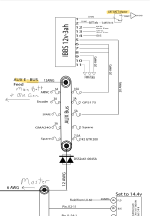I'm having a hard time envisioning a battery backup system in addition to an endurance bus. I'm largely running with Z-11 (Aeroelectric Connection). I have an IBBS system as well. So in my system, panel wise, I'd have (among others):
Switch: Master - On/Off
Switch: Battery/Aux - On/Off
Switch: E-Bus - On/Off
The master is on until a need arises, then master goes off, and E-bus goes on. We run off the E-bus until a) landing and need full systems until touchdown at which point E-bus goes off and master comes back on, or b) things really descend (unfortunate pun) and either the backup kicks in due to low voltage or I kick it over via the switch and we run on that until lights go out.
Does this sound correct?
Is there a concern with the IBBS sense wire being on the E-bus after the voltage drop of a diode?
Now, while we're up in the hypothetical air in my failing plane, I also have an alt. field breaker, which in my scenario I've pulled, removing charging current from the system. Having this breaker is the equivalent of:
Switch: Master - Alt/Batt/Off
Correct? Where the three position switch reserves the middle position to remove the current going to the alternator field?
Much appreciate anyone who can help shed some light here, and thank you in advance.
Switch: Master - On/Off
Switch: Battery/Aux - On/Off
Switch: E-Bus - On/Off
The master is on until a need arises, then master goes off, and E-bus goes on. We run off the E-bus until a) landing and need full systems until touchdown at which point E-bus goes off and master comes back on, or b) things really descend (unfortunate pun) and either the backup kicks in due to low voltage or I kick it over via the switch and we run on that until lights go out.
Does this sound correct?
Is there a concern with the IBBS sense wire being on the E-bus after the voltage drop of a diode?
Now, while we're up in the hypothetical air in my failing plane, I also have an alt. field breaker, which in my scenario I've pulled, removing charging current from the system. Having this breaker is the equivalent of:
Switch: Master - Alt/Batt/Off
Correct? Where the three position switch reserves the middle position to remove the current going to the alternator field?
Much appreciate anyone who can help shed some light here, and thank you in advance.


